Hala EXHIBITION art PIECES
Mauliola

Mauliola
Marques Hanalei Marzan
Hala
72” x 36” x 72”
2025
Mauliola is an installation that includes a plaited moena on the ground with a suspended work that hangs above it, all made with hala. Drawing on both earthly and heavenly energies through the spatial arrangement of the work helps me convey my understanding of what hala means to me and how it plays a role in preserving and healing community. The physical act of plaiting brings together separate elements to become stronger as one. Supporting our community is an act of supporting ourselves and uplifts us as a collective.
Hala
72” x 36” x 72”
2025
Mauliola is an installation that includes a plaited moena on the ground with a suspended work that hangs above it, all made with hala. Drawing on both earthly and heavenly energies through the spatial arrangement of the work helps me convey my understanding of what hala means to me and how it plays a role in preserving and healing community. The physical act of plaiting brings together separate elements to become stronger as one. Supporting our community is an act of supporting ourselves and uplifts us as a collective.
Woven Photographs

Woven Photographs
Yola Monakhov Stockton & Mei Lin Wong-Gary
2025
The works on paper in this exhibition were woven from darkroom photographs as a collaboration between Yola Monakhov Stockton, an artist and photographer, and Mei Lin Wong-Gary, a weaver of lauhala for over 30 years. Monakhov Stockton creates and strips photographic prints, which Wong-Gary weaves, in honor of her kumu, Auntie Minnie Ka‘awaloa and auntie Lily Sugahara, often incorporating improvisation as part of a conversation about meaning.
2025
The works on paper in this exhibition were woven from darkroom photographs as a collaboration between Yola Monakhov Stockton, an artist and photographer, and Mei Lin Wong-Gary, a weaver of lauhala for over 30 years. Monakhov Stockton creates and strips photographic prints, which Wong-Gary weaves, in honor of her kumu, Auntie Minnie Ka‘awaloa and auntie Lily Sugahara, often incorporating improvisation as part of a conversation about meaning.
Kiʻi, Ohiohikupua

Kiʻi, Ohiohikupua
G. Pualani Muraki
Kiʻi, Ohiohikupua
Dyed split round rattan reed fiber, hala leaves,lete,mother of peartshell,wood and waxed linen thread, image dyed with candlenut bark dye and oiled with kukui oil
18” W X 18” L X 39” H
'Ohi'ohikupua is the name of the Hala plant. In ka wākahiko, 'Ohi'ohikupua was introduced to Hawai'i through her encounter with Pele during Pele's travel from Kahiki. In Pele's rage, she flung the blossoms of 'Ohi'ohikupua in all directions, resulting in the first Hala growth in Hawai'i atNiuli'i on the moku of Hawai'i. The art of lauhala weaving lives on through 'Ohi'ohikupua. It is through my practices of hula and the art of lauhala weaving that my pilina with'Ohi'ohikupua comes from.
Kiʻi, Ohiohikupua
Dyed split round rattan reed fiber, hala leaves,lete,mother of peartshell,wood and waxed linen thread, image dyed with candlenut bark dye and oiled with kukui oil
18” W X 18” L X 39” H
'Ohi'ohikupua is the name of the Hala plant. In ka wākahiko, 'Ohi'ohikupua was introduced to Hawai'i through her encounter with Pele during Pele's travel from Kahiki. In Pele's rage, she flung the blossoms of 'Ohi'ohikupua in all directions, resulting in the first Hala growth in Hawai'i atNiuli'i on the moku of Hawai'i. The art of lauhala weaving lives on through 'Ohi'ohikupua. It is through my practices of hula and the art of lauhala weaving that my pilina with'Ohi'ohikupua comes from.
Kepo‘ohalaikawelo

Kepo‘ohalaikawelo
Ka‘ohu Seto
“To carry on the virtues arts and skills of the family”
Made from leaves gathered from Niuliʻi
30”x30’
2012
“To carry on the virtues arts and skills of the family”
Made from leaves gathered from Niuliʻi
30”x30’
2012
He Mele No Haleola
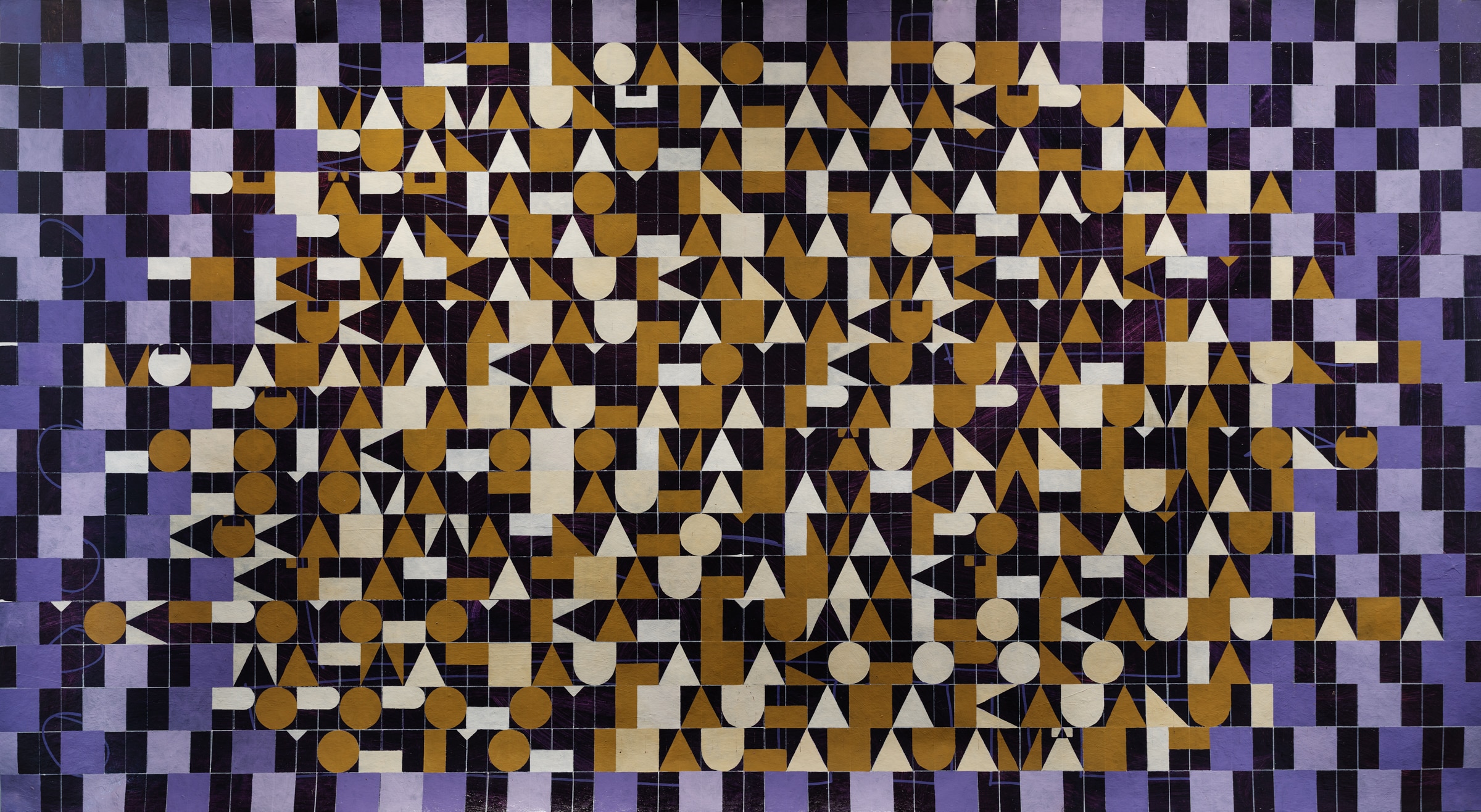
He Mele No Haleola
Carl F.K. Pao
Acrylic And Shellac On Builders Paper
38"H X 70"W
2025
Inspired by the mele “He Mele No Haleola” by Dr. Taupōuri Tangarō and taught to us by the Kōhala Center ʻohana during our year together as our exhibiting hui. The mele teaches us the process of hala making. What you see before you is the mele, which reads from the bottom up and left to right in my personal font. The font itself represents a fusion of ʻōiwi Hawaiʻi concepts and Western writing systems to create a visual hybrid.
Acrylic And Shellac On Builders Paper
38"H X 70"W
2025
Inspired by the mele “He Mele No Haleola” by Dr. Taupōuri Tangarō and taught to us by the Kōhala Center ʻohana during our year together as our exhibiting hui. The mele teaches us the process of hala making. What you see before you is the mele, which reads from the bottom up and left to right in my personal font. The font itself represents a fusion of ʻōiwi Hawaiʻi concepts and Western writing systems to create a visual hybrid.
Hala Huina

Hala Huina
Mei Lin Wong-Gary And Carl F.K. Pao
Acrylic And Shellac On Builders Paper
60"H X 36"W
2025
“Hala Huina” is the result of a collaboration between myself and master weaver Mei Lin Wong-Gary. We both live minutes away from each other. Our main road that connects us is Huina Rd. Huina means to gather or a place of gathering. What brought us together was this project about hala. But it was the hala that is in Mei Lin’s front yard that was the key to our collab. When we realized that we were neighbors, I immediately asked her about that poor hala tree by her house and what had happened to it. Mei Lin replied, “ That’s my tree and I just pruned it.” Embarrassed because I had accused whomever had done to the tree what I had seen, must had done the tree wrong. Yet, I learned a lesson that what that hala tree looked like after a master pruned it is how it should look. So, it made sense to approach Mei Lin to do a collab with my paintings and her weaving mastery. Hala is not only the connecting element, but also signifies the potential for more to come. Mahalo piha e Mei Lin! Mahalo piha e hala!
Acrylic And Shellac On Builders Paper
60"H X 36"W
2025
“Hala Huina” is the result of a collaboration between myself and master weaver Mei Lin Wong-Gary. We both live minutes away from each other. Our main road that connects us is Huina Rd. Huina means to gather or a place of gathering. What brought us together was this project about hala. But it was the hala that is in Mei Lin’s front yard that was the key to our collab. When we realized that we were neighbors, I immediately asked her about that poor hala tree by her house and what had happened to it. Mei Lin replied, “ That’s my tree and I just pruned it.” Embarrassed because I had accused whomever had done to the tree what I had seen, must had done the tree wrong. Yet, I learned a lesson that what that hala tree looked like after a master pruned it is how it should look. So, it made sense to approach Mei Lin to do a collab with my paintings and her weaving mastery. Hala is not only the connecting element, but also signifies the potential for more to come. Mahalo piha e Mei Lin! Mahalo piha e hala!
Papale Anoni

Papale Anoni
G. Pualani Muraki
Lauhala
5 inches high, 14 inches across
2025
Lauhala
5 inches high, 14 inches across
2025
Mālama ke kumu me ka lokomaika'i

Mālama ke kumu me ka lokomaika'i
Debbie Toko
Lauhala
5 inches high, 14 inches across
2025
Lauhala
5 inches high, 14 inches across
2025
Pāpale Lau Hala - Muliwai

Pāpale Lau Hala - Muliwai
Kahina Hewitt
Lau Hala
3” brim, 4” tall, 14” total length
2021
Lau Hala
3” brim, 4” tall, 14” total length
2021
Pāpale Paniolo

Pāpale Paniolo
Kilinoe Muraki-Burns
Lauhala
2023
Lauhala
2023
ʻEke Mahina Hapalua

ʻEke Mahina Hapalua
Kilinoe Muraki-Burns
Lauhala
2024-2025
Lauhala
2024-2025
Kāloakūkahi Clutch
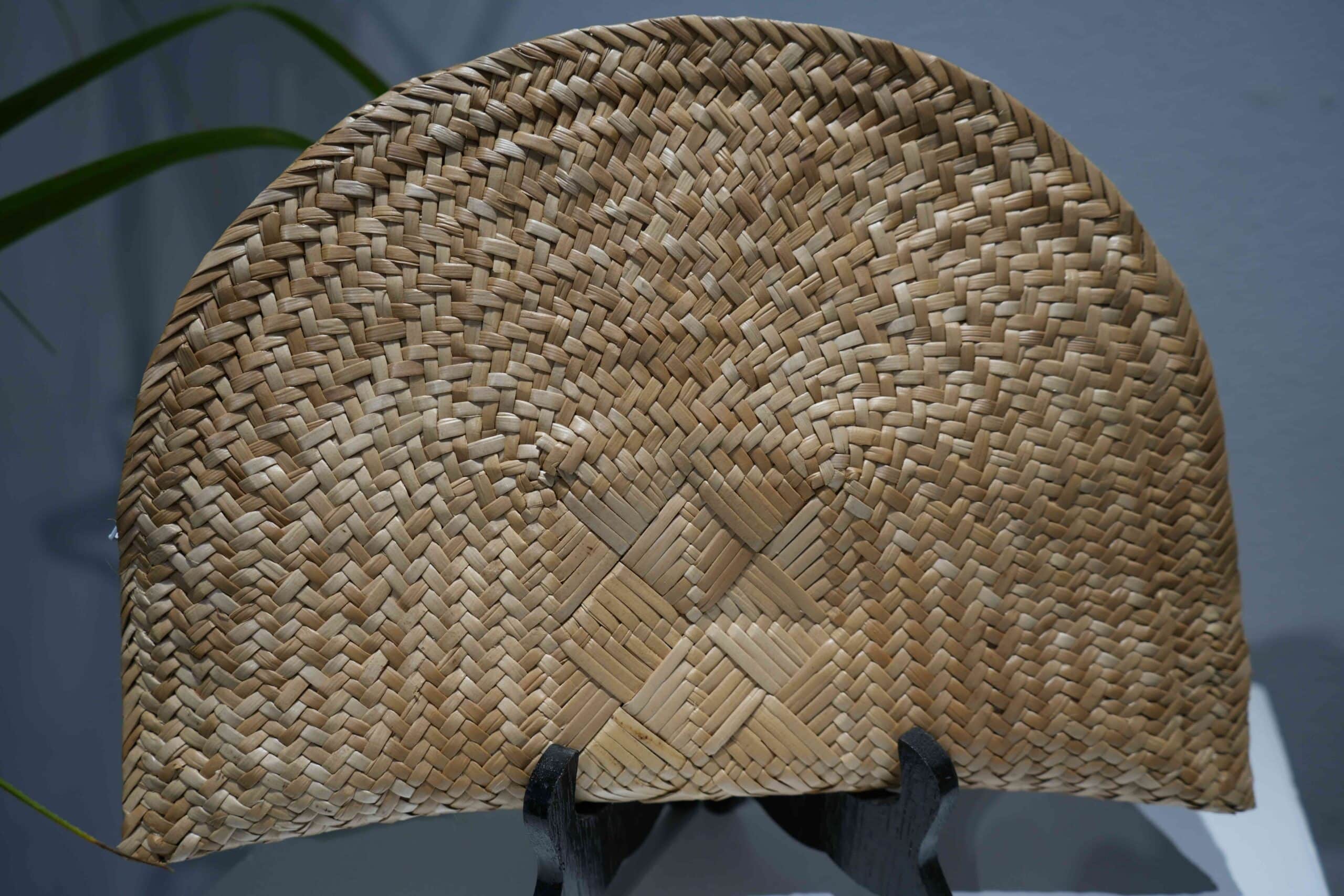
Kāloakūkahi Clutch
Kahina Hewitt
Lau Hala
12” wide x 8 1/2” tall
2024
Lau Hala
12” wide x 8 1/2” tall
2024
Moena Piko
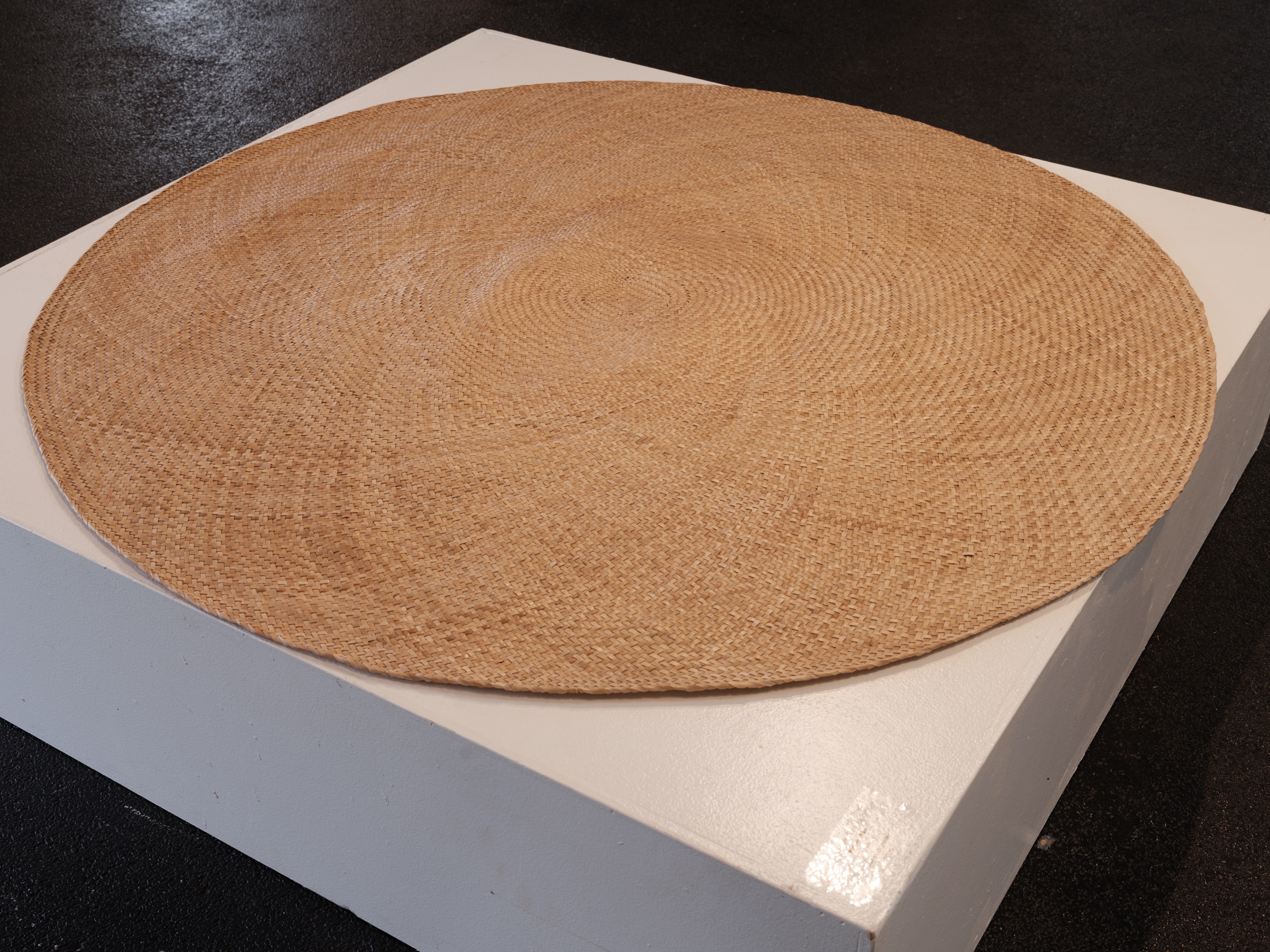
Moena Piko
Dee Shimabukuro
Lauhala
50” in. diameter
2025
Lauhala
50” in. diameter
2025
Loveknot Moena

Loveknot Moena
Mei Lin Wong-Gary
Loveknot Moena
Lauhala
27” x 43” in.
2000
This moena is over 25 years old. It was the first of several more to come. It took me several years of inconsistent weaving to complete. Back in those days, my knowledge of lau hala preparation and matching colors was next to none. I only knew the joy of weaving and creating when the time and the mood hit.
Loveknot Moena
Lauhala
27” x 43” in.
2000
This moena is over 25 years old. It was the first of several more to come. It took me several years of inconsistent weaving to complete. Back in those days, my knowledge of lau hala preparation and matching colors was next to none. I only knew the joy of weaving and creating when the time and the mood hit.
Loveknot Moena

Loveknot Moena
Alexis Keenan
Lauhala
34“ x 28” in.
2025
In this project my I‘imi, Alexis Keenan, was required to separate her lauhala by similar colors before rolling into a kuʻkaa. After she stripped the lauhala, she again sorted her koana by color shades of light, medium, and dark. Before she joined her woven 5x5 pieces together, she intentionally arranged them by similar color to create a piece that was pleasing to her eyes.
Lauhala
34“ x 28” in.
2025
In this project my I‘imi, Alexis Keenan, was required to separate her lauhala by similar colors before rolling into a kuʻkaa. After she stripped the lauhala, she again sorted her koana by color shades of light, medium, and dark. Before she joined her woven 5x5 pieces together, she intentionally arranged them by similar color to create a piece that was pleasing to her eyes.
Play & Pilina
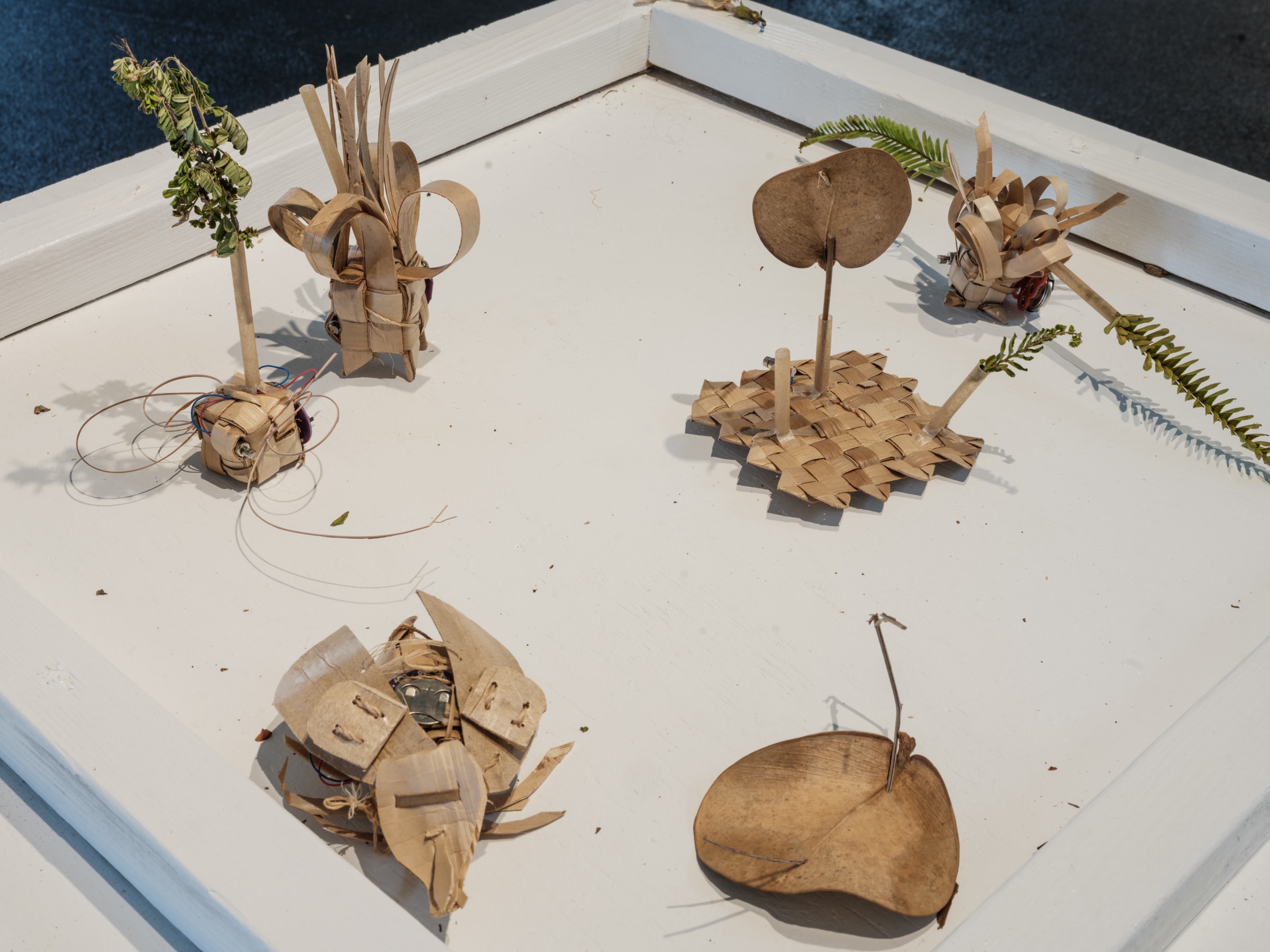
Play & Pilina
Corinne Okada Takara
Mixed media lauhala weaving
2025
Play & Pilina
My dad’s hanabata days were filled with making toys from whatever was around—natural materials, tire rubber, bottle caps. That childhood spirit of invention carried him from Maui’s Paʻia sugarcane plantation all the way to designing Star Wars toys and beyond. Now it’s your turn! Channel your inner toy designer by adding natural elements to these lauhala-woven bots, each outfitted with sugarcane straws and simple motors. Flip the small switch on the battery pack to bring your creation to life—then place it on the table and watch it dance. Be sure to turn it off when you're done so others can enjoy. How might we grow pilina—relationships—through playful acts of making? As we weave the future with hala, joy can be part of the design.
Mixed media lauhala weaving
2025
Play & Pilina
My dad’s hanabata days were filled with making toys from whatever was around—natural materials, tire rubber, bottle caps. That childhood spirit of invention carried him from Maui’s Paʻia sugarcane plantation all the way to designing Star Wars toys and beyond. Now it’s your turn! Channel your inner toy designer by adding natural elements to these lauhala-woven bots, each outfitted with sugarcane straws and simple motors. Flip the small switch on the battery pack to bring your creation to life—then place it on the table and watch it dance. Be sure to turn it off when you're done so others can enjoy. How might we grow pilina—relationships—through playful acts of making? As we weave the future with hala, joy can be part of the design.
Hala Makawalu 1

Hala Makawalu 1
Udi Mandel
Giclee print on Fine Art Paper
9 x 10”x18” photos with text
2025
Makawalu expresses a Hawaiian sensibility of inquiry and understanding phenomena from many perspectives. This piece, made from stills and quotes from interviews from a film that is being made about Hala also embodies the sensibility of makawalu in relation to Hala. Through these perspectives we capture glimpses of Hala being and acting in the world and developing relationships with people.
Giclee print on Fine Art Paper
9 x 10”x18” photos with text
2025
Makawalu expresses a Hawaiian sensibility of inquiry and understanding phenomena from many perspectives. This piece, made from stills and quotes from interviews from a film that is being made about Hala also embodies the sensibility of makawalu in relation to Hala. Through these perspectives we capture glimpses of Hala being and acting in the world and developing relationships with people.
Hala Makawalu 2

Hala Makawalu 2
Udi Mandel
Video
(45 min and 31 seconds)
2025
Makawalu expresses a Hawaiian sensibility of inquiry and understanding phenomena from many perspectives. This video shows interviews with several of the participants in the Hala exhibition. It is a selection from a film, in process, about the larger Hala project that spanned the last year. The interviews explore the relationships people have with Hala as both a being and a cultural practice.
Video
(45 min and 31 seconds)
2025
Makawalu expresses a Hawaiian sensibility of inquiry and understanding phenomena from many perspectives. This video shows interviews with several of the participants in the Hala exhibition. It is a selection from a film, in process, about the larger Hala project that spanned the last year. The interviews explore the relationships people have with Hala as both a being and a cultural practice.
Lines of Sight

Lines of Sight
Ryan Perroy, Justin Kellum, Udi Mandel, Mary Babcock, Kanani Daley, and You
Interactive Installation with aerial image courtesy of Ryan Perroy
Mixed media photography and drawing on tracing paper
148in x 92in
2025
Contemporary map makers use machine learning to trace the distribution of certain kinds of trees and plants using satellite imagery and aerial photography. Human map makers teach the machine to recognize the patterns of such trees and plants through an interactive process in which the humans cross reference aerial images with actual in-person identification, and then feed this information back to the machine which in turn creates ever-more elaborate algorithms. The repetition of this process leads to increasing accuracy. Despite hala’s ubiquity across Hawaii Island, many humans have become blind to their presence and importance. In this installation, we ask you to help us see hala again. You are invited to locate and trace a hala tree. Trace its contours with the provided tracing paper and pencils. Once you’ve completed your tracing, place it on the wall next to the photograph, trying to match its placement with where you have traced, using the magnets to adhere it to the metal strips.
Interactive Installation with aerial image courtesy of Ryan Perroy
Mixed media photography and drawing on tracing paper
148in x 92in
2025
Contemporary map makers use machine learning to trace the distribution of certain kinds of trees and plants using satellite imagery and aerial photography. Human map makers teach the machine to recognize the patterns of such trees and plants through an interactive process in which the humans cross reference aerial images with actual in-person identification, and then feed this information back to the machine which in turn creates ever-more elaborate algorithms. The repetition of this process leads to increasing accuracy. Despite hala’s ubiquity across Hawaii Island, many humans have become blind to their presence and importance. In this installation, we ask you to help us see hala again. You are invited to locate and trace a hala tree. Trace its contours with the provided tracing paper and pencils. Once you’ve completed your tracing, place it on the wall next to the photograph, trying to match its placement with where you have traced, using the magnets to adhere it to the metal strips.
Ka ‘Au ‘Ana O Ka Wa‘a

Ka ‘Au ‘Ana O Ka Wa‘a
Sean Connelly
Video
(5 min and 31 seconds)
2025
These two video cartographies integrate geospatial data on wind, water, soil, sun, and ground, drawing subtle connections through the spirit and utility of hala to link ocean, canoe, and land. In the first video Ka ‘au ‘ana O Ka Wa‘a: Sailing The Canoe, hala is considered as a means to harness wind and foster movement as a Native building material for making canoe sails. Wind data from Pae ‘Āina Hawai‘i subtly transforms into the image of backbones, symbolizing wind’s fundamental role as both the structural support for canoe navigation, and as a connecting force, a backbone, that connects people to history and place. It is set to a pule (prayer) offered by Lanakila Mangauil.
Video
(5 min and 31 seconds)
2025
These two video cartographies integrate geospatial data on wind, water, soil, sun, and ground, drawing subtle connections through the spirit and utility of hala to link ocean, canoe, and land. In the first video Ka ‘au ‘ana O Ka Wa‘a: Sailing The Canoe, hala is considered as a means to harness wind and foster movement as a Native building material for making canoe sails. Wind data from Pae ‘Āina Hawai‘i subtly transforms into the image of backbones, symbolizing wind’s fundamental role as both the structural support for canoe navigation, and as a connecting force, a backbone, that connects people to history and place. It is set to a pule (prayer) offered by Lanakila Mangauil.
Hala Studies
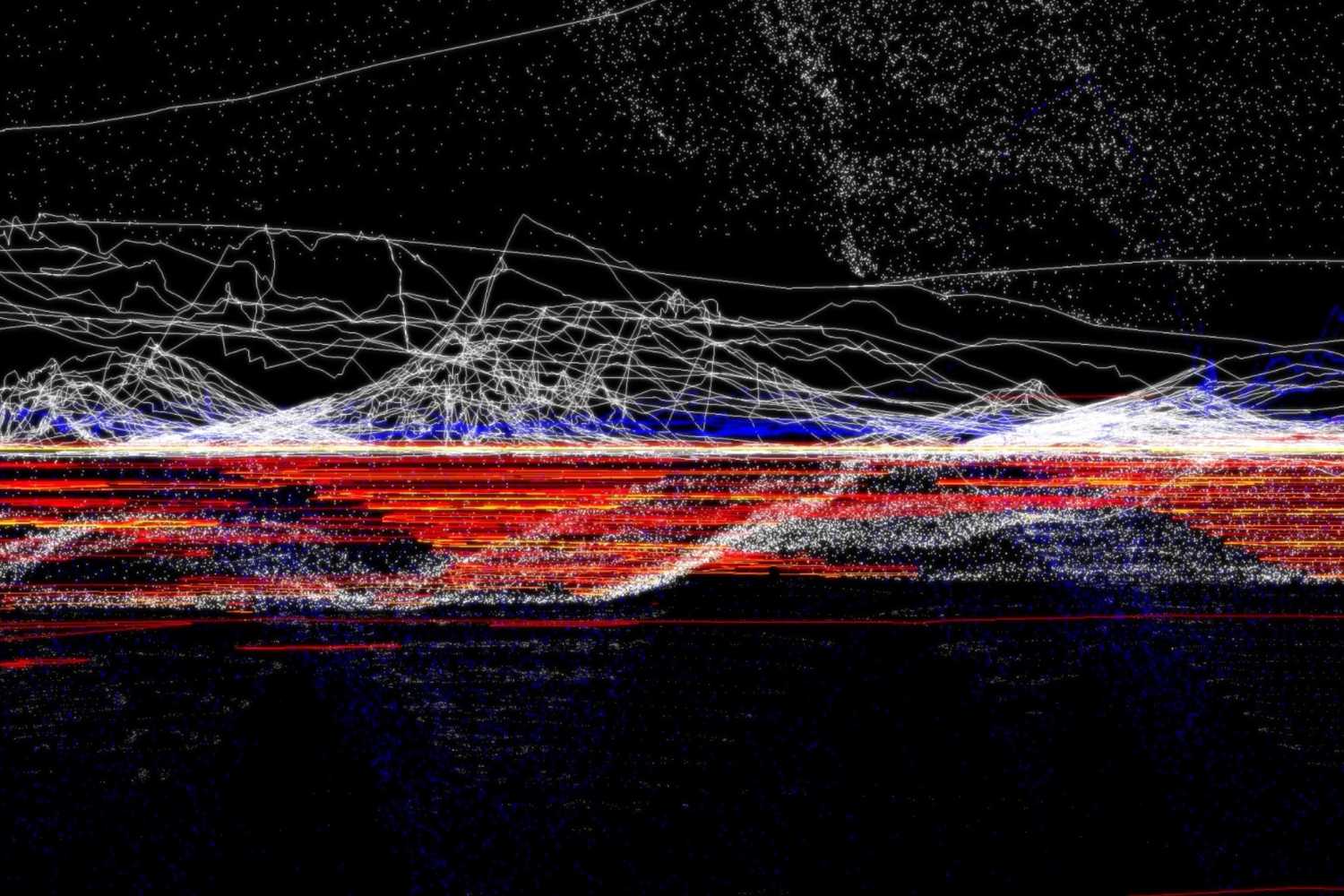
Hala Studies
Sean Connelly
Videov (13 min and 39 seconds) 2025
In Hala Studies, viewers traverse the threshold between land, sea, and sky via GIS data and architectural modeling. As the camera glides backward from Kumukahi to Lehua across a digital model of Pae ‘Āina Hawai‘i, it is accompanied by the resonant sounds of hala weaving contributed by Lise Michelle Childers and Corinne Okada Takara.
Videov (13 min and 39 seconds) 2025
In Hala Studies, viewers traverse the threshold between land, sea, and sky via GIS data and architectural modeling. As the camera glides backward from Kumukahi to Lehua across a digital model of Pae ‘Āina Hawai‘i, it is accompanied by the resonant sounds of hala weaving contributed by Lise Michelle Childers and Corinne Okada Takara.
Geographic Distribution of Hala across Hawai’i island
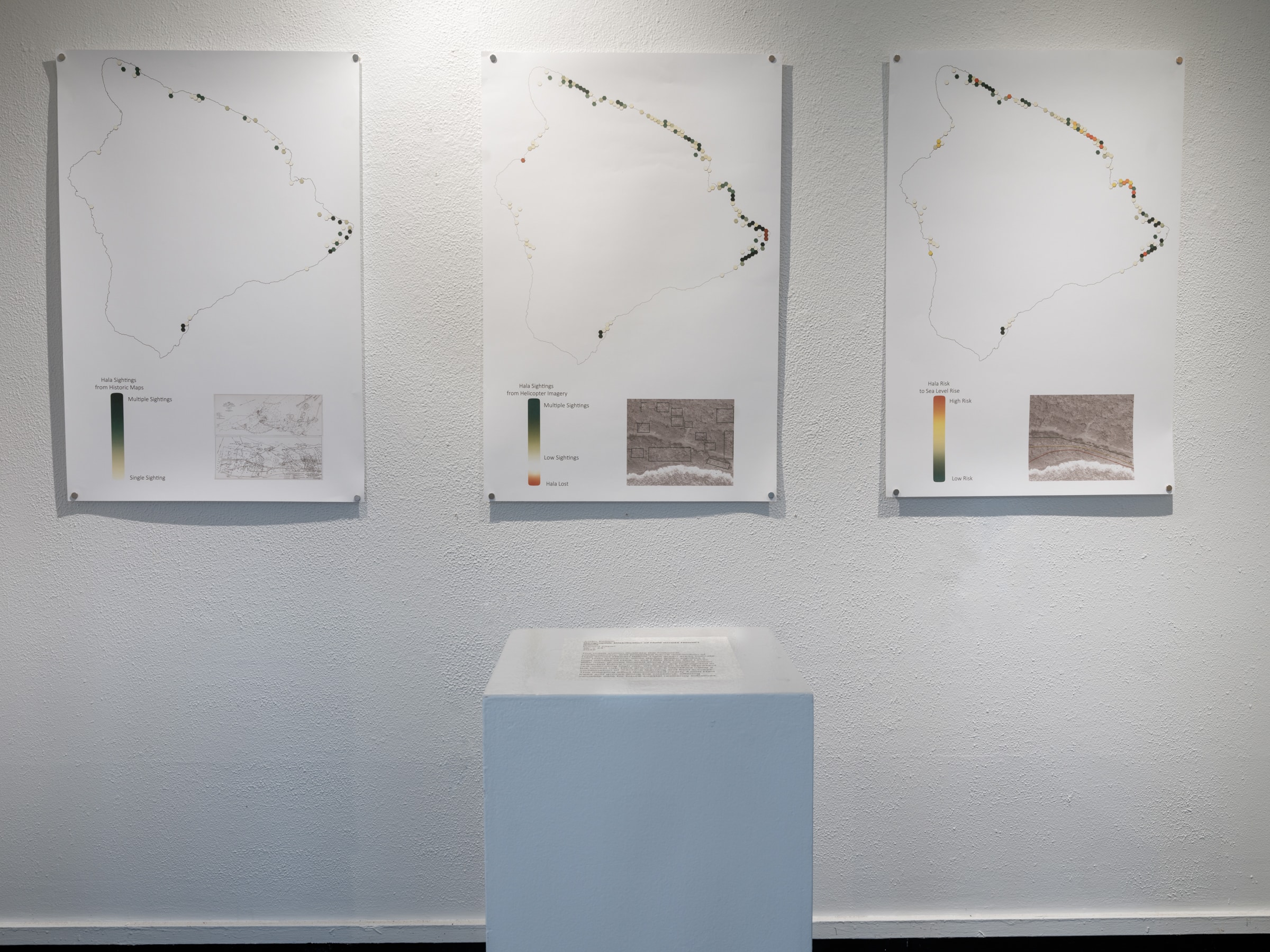
Geographic Distribution of Hala across Hawai’i island
Justin Kellam
Printed paper
36” x 24”
2025
The maps shown illustrate the historical, contemporary, and projected future distribution of Hala across Hawai‘i Island. Light green areas indicate low Hala presence, while darker green signifies a high density of Hala. In the Hala Risk to Sea Level Rise map, groves located along the coastline within predicted future inundation zones are highlighted in red, indicating high risk, while green areas represent the lowest risk. Hala groves were identified using a combination of machine learning and field surveys. This mapping effort documented nearly 4,000 Hala trees and groves along the coastline, offering valuable data for future coastal resiliency initiatives.
Printed paper
36” x 24”
2025
The maps shown illustrate the historical, contemporary, and projected future distribution of Hala across Hawai‘i Island. Light green areas indicate low Hala presence, while darker green signifies a high density of Hala. In the Hala Risk to Sea Level Rise map, groves located along the coastline within predicted future inundation zones are highlighted in red, indicating high risk, while green areas represent the lowest risk. Hala groves were identified using a combination of machine learning and field surveys. This mapping effort documented nearly 4,000 Hala trees and groves along the coastline, offering valuable data for future coastal resiliency initiatives.
Who is hala?

Who is hala?
The Kohala Center
Kilo Installation
2025
Kilo is a Hawaiian practice of embodied observation. Using all senses–seeing, hearing, touching, smelling, tasting, and feeling–the process of kilo allows us to connect with and gather data about ʻāina, environments, and environmental kin. Anyone who has a desire to care for ʻāina can use kilo as a tool for data collection in order to learn more about the regular cycles and standout events affecting that ʻāina. Kilo data gathered over time can then be used to make informed decisions about ʻāina stewardship. This installation was designed to be an interactive kilo experience, allowing viewers to observe natural materials from the uluhala (hala grove) at Niuliʻi, Kohala. We invite you to respectfully engage with these materials through kilo, using all of your senses.
Kilo Installation
2025
Kilo is a Hawaiian practice of embodied observation. Using all senses–seeing, hearing, touching, smelling, tasting, and feeling–the process of kilo allows us to connect with and gather data about ʻāina, environments, and environmental kin. Anyone who has a desire to care for ʻāina can use kilo as a tool for data collection in order to learn more about the regular cycles and standout events affecting that ʻāina. Kilo data gathered over time can then be used to make informed decisions about ʻāina stewardship. This installation was designed to be an interactive kilo experience, allowing viewers to observe natural materials from the uluhala (hala grove) at Niuliʻi, Kohala. We invite you to respectfully engage with these materials through kilo, using all of your senses.
Hoʻomau Hala

Hoʻomau Hala
Kū-A-Kanaka
Video 45min
This video was produced by Kū-A-Kanaka, a Hawaiian family-owned and operated culture-based social enterprise headquartered on Hawaiʻi Island, for the 2025 Wailoa Hala Exhibit. Entitled Hoʻomau Hala, which means “to continue (the use of) hala”, this video is a compilation of multiple interactive slideshows from a highly interactive, culture-based, asynchronous online course, made up of 8 Lessons, requiring about 4 - 6 hours of engagement per lesson. Featuring information about hala and lauhala weaving, including vocabulary, gathering, preparing and weaving processes, origins, stories, proverbs, songs, chants etc, this course provides a basic introduction to anyone interested in learning theoretical aspects of Hala.
Video 45min
This video was produced by Kū-A-Kanaka, a Hawaiian family-owned and operated culture-based social enterprise headquartered on Hawaiʻi Island, for the 2025 Wailoa Hala Exhibit. Entitled Hoʻomau Hala, which means “to continue (the use of) hala”, this video is a compilation of multiple interactive slideshows from a highly interactive, culture-based, asynchronous online course, made up of 8 Lessons, requiring about 4 - 6 hours of engagement per lesson. Featuring information about hala and lauhala weaving, including vocabulary, gathering, preparing and weaving processes, origins, stories, proverbs, songs, chants etc, this course provides a basic introduction to anyone interested in learning theoretical aspects of Hala.
Maerten’s Ohana Collection
Na Mea Ulana Lauhala
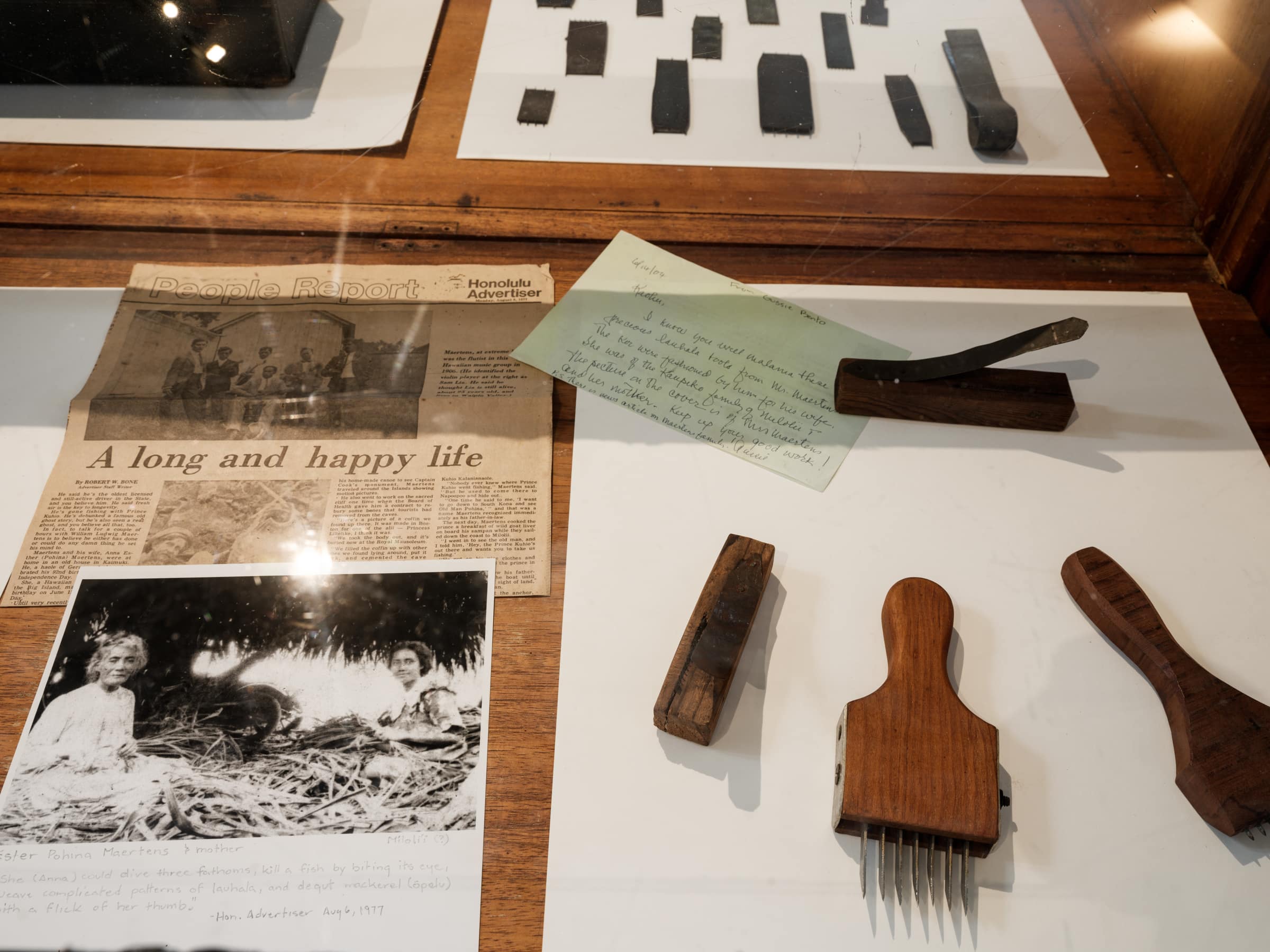
Maerten’s Ohana Collection
Na Mea Ulana Lauhala
Ka‘ohu Seto
1900
“These tools came to me through Gussie Bento, who was the curator of the Pauhai Heritage Center on the Kapālama Campus, Oahu. She was given these tools by somebody from the Maerten family. William Maerten is the one in the article that talks about him and his wife who was a weaver. William Maerten made those tools in the display for his wife and they had a cottage industry making lauhala hats and other things from lauhala. So he manufactured the lauhala tools in the iron works in the plantation where he worked. Every sugarcane plantation had their own ironwork yard so I believe he took scraps and made those tools for his wife.
1900
“These tools came to me through Gussie Bento, who was the curator of the Pauhai Heritage Center on the Kapālama Campus, Oahu. She was given these tools by somebody from the Maerten family. William Maerten is the one in the article that talks about him and his wife who was a weaver. William Maerten made those tools in the display for his wife and they had a cottage industry making lauhala hats and other things from lauhala. So he manufactured the lauhala tools in the iron works in the plantation where he worked. Every sugarcane plantation had their own ironwork yard so I believe he took scraps and made those tools for his wife.
Pūole Moe

Pūole Moe
Ka‘ohu Seto
Lauhala Burial Basket
14”x14”x22”
2025
Lauhala Burial Basket
14”x14”x22”
2025
Hala flourishing futures

Hala flourishing futures
Curators (Udi Mandel, Mary Babcock, Kanani Daley)
Mixed media (map, hala plants, pins, labels)
2025
You are invited to take a hala keiki home to plant and care for it. Please take one per ohana and add a pin to the map to where you will be planting this. On the label write your vision for a flourishing hala future and attach this label to your pin.
HAla economies/
wayfinding keaukaha

HAla economies/
wayfinding keaukaha
Kelly Teamey and Mary Babcock
lehala, plastic retail tags, receipt on paper
*text excerpted from Nā Pana Kaulana o Keaukaha by Edith Kanakaole and from Google Maps
diptych, 40” x 26” each
2025
The root of the word “economy” means “management of a household.” Lauhala was once used in all parts of the household, woven from local hala groves, creating a continuous cycle of intimate connection between tree, grove, weaver and household. Today, many lauhala materials arrive into Hawaiʻi through global flows of economic trade with little or no information about its origins. In this work, Kelly inquires into hala economies. We track her own embodied path of learning in the ʻāina in which she lives - Keaukaha - as she walks to gather and process ulehala from her home in contrast to driving and purchasing an imported lauhala basket from a U.S. arts and craft chain store.
